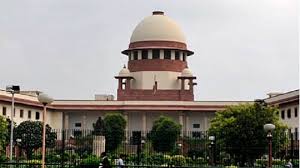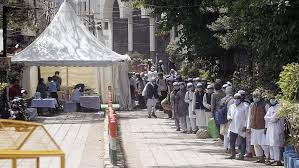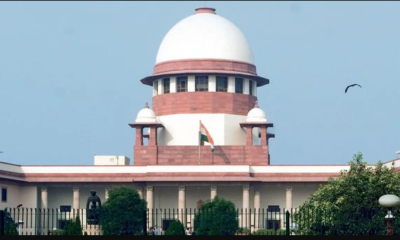Feature
Sex With Minor Wife is Rape, Age of Consent is 18: Supreme Court

New Delhi : The raging issue whether to make forced marital intercourse and sexual acts part of offence of rape in penal law has been extensively debated and now it cannot be considered as a criminal act, the Supreme Court today said. Section 375 of the Indian Penal Code (IPC), which defines the offence of rape, has an exception clause that says the intercourse or sexual act by a man with his wife, not below 15 years, is not a rape.
“Parliament has extensively debated the issue of marital rape and considered that it was not an offence of rape. Therefore, it cannot be considered as a criminal offence,” a bench of justices M B Lokur and Deepak Gupta said.
The apex court also said that marriage of a girl, who is below the age of 15 years, was “illegal”.
“There are cases when college-going teens, below 18 years of age, engage in sexual activities consensually and get booked under the law. Who is going to suffer? The boy is not at fault. The punishment of seven years is too harsh,” the bench observed. It said, similarly, problem arises when a girl, under 18 years of age, elopes and engages in consensual sexual activity, the male gets booked for rape.
“In these cases, we do have problem if look at various aspects,” the bench said as it asked the Centre to apprise it about the number of prosecutions under the Child Marriage Act for past three years in three weeks. It also asked Centre to apprise it about appointment of the Child Marriage Prohibition Officers (CMPO) under statutory provisions in the country and posted the matter for hearing after four weeks.
The bench was hearing a plea questioning the constitutionality of a provision permitting a man to have physical relationship with his wife even if she is aged between 15 and 18. The apex court said according to prevailing law, if a man has physical intercourse with a girl under 15 years of age, it is termed as rape irrespective of “consent or no consent” and if she is below 18 years of age, but more than 15 and married, then no offence of rape is made out.
Advocate Gaurav Agarwal appearing for NGO Independent Thought said that distinction made in between 18 and 15 is illegal and unconstitutional. “Parliament cannot impinge upon Article 21 by allowing the girl to marry under 18 years of age and allowing her to get pregnant or have intercourse. The Parliament should have considered various reports of the United Nations,” he said.
He said that a girl in the age group of 15-18 is not that physically developed and she is not capable of taking an informed decision or consent.
“The State has failed to protect her as there is no protection for her is she is below 18. Above 18 years of age she is developed and can think of coming out of abusive relationship,” the lawyer said. Senior advocate Gopal Subramaniam, who was part of the Justice J S Verma Committee constituted in the aftermath of the December 16 gangrape in Delhi and was present in the courtroom said, they had considered various aspects and after that, suggestion to criminalise marital rape was made.
The committee was headed by former Chief Justice J S Verma and comprised former judge Leila Seth and Subramaniam. “Without any renumeration we have submitted the report to the government and that too without any extension. It was an exhaustive work,” he said.
It has also referred to the provisions of the Protection of Children from Sexual Offences Act (POCSO), 2012, and said these provisions were contrary to the IPC provision. The POCSO provision provides that physical relationship with a minor constitutes the offence of rape and it does not exclude such relationship between a man and his minor wife.
Entertainment
Meghalaya Reserves Legalized Gambling and Sports Betting for Tourists

The State Scores Extra High on Gaming-Friendly Industry Index
Meghalaya scored 92.85 out of 100 possible points in a Gaming Industry Index and proved to be India’s most gaming-friendly state following its recent profound legislation changes over the field allowing land-based and online gaming, including games of chance, under a licensing regime.
The index by the UK India Business Council (UKIBC) uses a scale of 0 to 100 to measure the level of legalisation on gambling and betting achieved by a state based on the scores over a set of seven different games – lottery, horse racing, betting on sports, poker, rummy, casino and fantasy sports
Starting from February last year, Meghalaya became the third state in India’s northeast to legalise gambling and betting after Sikkim and Nagaland. After consultations with the UKIBC, the state proceeded with the adoption of the Meghalaya Regulation of Gaming Act, 2021 and the nullification of the Meghalaya Prevention of Gambling Act, 1970. Subsequently in December, the Meghalaya Regulation of Gaming Rules, 2021 were notified and came into force.
All for the Tourists
The move to legalise and license various forms of offline and online betting and gambling in Meghalaya is aimed at boosting tourism and creating jobs, and altogether raising taxation revenues for the northeastern state. At the same time, the opportunities to bet and gamble legally will be reserved only for tourists and visitors.
“We came out with a Gaming Act and subsequently framed the Regulation of Gaming Rules, 2021. The government will accordingly issue licenses to operate games of skill and chance, both online and offline,” said James P. K. Sangma, Meghalaya State Law and Taxation Minister speaking in the capital city of Shillong. “But the legalized gambling and gaming will only be for tourists and not residents of Meghalaya,” he continued.
To be allowed to play, tourists and people visiting the state for work or business purposes will have to prove their non-resident status by presenting appropriate documents, in a process similar to a bank KYC (Know Your Customer) procedure.
Meghalaya Reaches Out to a Vast Market
With 140 millions of people in India estimated to bet regularly on sports, and a total of 370 million desi bettors around prominent sporting events, as per data from one of the latest reports by Esse N Videri, Meghalaya is set to reach out and take a piece of a vast market.
Estimates on the financial value of India’s sports betting market, combined across all types of offline channels and online sports and cricket predictions and betting platforms, speak about amounts between $130 and $150 billion (roughly between ₹9.7 and ₹11.5 lakh crore).
Andhra Pradesh, Telangana and Delhi are shown to deliver the highest number of bettors and Meghalaya can count on substantial tourists flow from their betting circles. The sports betting communities of Karnataka, Maharashtra, Uttar Pradesh and Haryana are also not to be underestimated.
Among the sports, cricket is most popular, registering 68 percent of the total bet count analyzed by Esse N Videri. Football takes second position with 11 percent of the bets, followed by betting on FIFA at 7 percent and on eCricket at 5 percent. The last position in the Top 5 of popular sports for betting in India is taken by tennis with 3 percent of the bet count.
Local Citizens will Still have Their Teer Betting
Meghalaya residents will still be permitted to participate in teer betting over arrow-shooting results. Teer is a traditional method of gambling, somewhat similar to a lottery draw, and held under the rules of the Meghalaya Regulation of the Game of Arrow Shooting and the Sale of Teer Tickets Act, 2018.
Teer includes bettors wagering on the number of arrows that reach the target which is placed about 50 meters away from a team of 20 archers positioned in a semicircle.
The archers shoot volleys of arrows at the target for ten minutes, and players place their bets choosing a number between 0 and 99 trying to guess the last two digits of the number of arrows that successfully pierce the target.
If, for example, the number of hits is 256, anyone who has bet on 56 wins an amount eight times bigger than their wager.
























